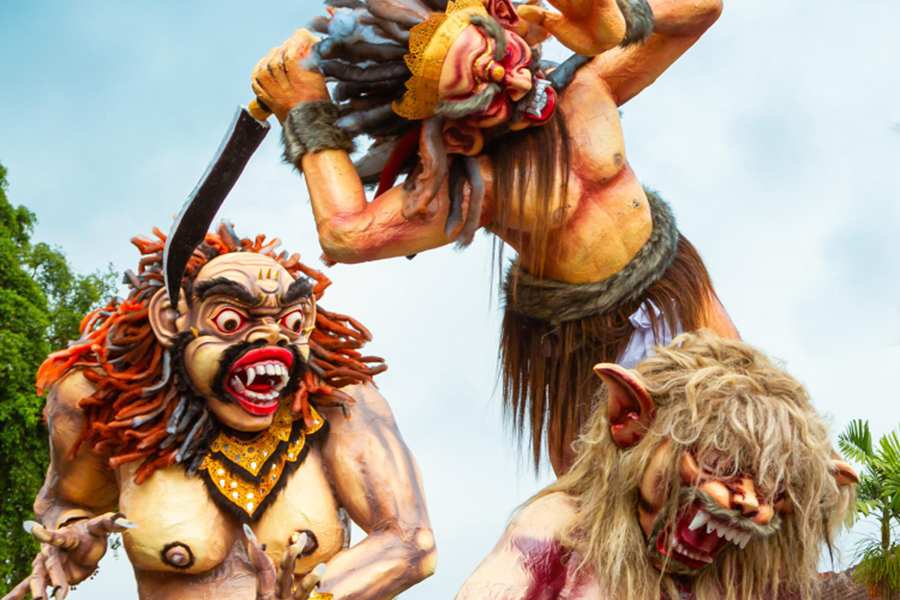BALI OGOH – OGOH
BALI OGOH – OGOH IS A SYMBOL OF A GIANT CREATURE THAT HAS A SCARY AND FEROCIOUS APPEARANCE

The Balinese Ogoh-Ogoh is closely associated with the Nyepi Day celebrations in Bali Island. Ogoh-ogoh can be considered as one of the most exciting events in the Nyepi ceremony. On the night of Pengrupukan, which is the day before the Saka New Year or Nyepi Day, the ogoh-ogohs, which look scary, are paraded around the village or town by the people of the banjar or traditional village, especially by the youth. The ogoh-ogoh festival on the Bali Island is held in the afternoon in each village, with some being paraded to the town centre before returning to the village, while others go straight to the cemetery to be burnt. It is believed that by burning the ogoh-ogoh, negative energy will also be burnt and dissipated. The ogoh-ogoh parade is sacred and very important to Balinese Hindus and takes place the day before Nyepi.
All you need to know about Ogoh-Ogoh:
- Ogoh-Ogoh Made From
- Process Making Ogoh-Ogoh
- Ogoh-Ogoh Taking Form
- The History of Ogoh-Ogoh
- Ogoh-Ogoh Festival
- Ogoh-Ogoh Festival Location
Ogoh-Ogoh Made From
Ogoh-ogoh is a giant statue or doll made of lightweight materials such as a combination of wood, bamboo, paper, and styrofoam, making it easier to lift and parade. Along with the development of technology and materials, people tend to use styrofoam because it is lightweight, easy to carve and process, although the price is more expensive. Ogoh-ogoh is made in the form of Bhuta Kala or evil spirits and creatures that like to disturb human life. Bhuta Kala is usually symbolised as a giant creature or Rakshasa with a scary and ferocious appearance. Bhuta Kala is a type of evil being that carries a bad nature within itself. In Hindu and Buddhist mythology, the term “rakshasa” is believed to mean “cruelty”, which is the opposite of “Raksha” which means “tranquility”. By parading and burning or destroying ogoh-ogoh, it is hoped that these bad traits can be kept away from humans.
Process Making Ogoh-Ogoh
The process of making ogoh-ogoh begins about 3 months before Pengrupukan Day in each village. At this early stage, the materials for the ogoh-ogoh are prepared, and each village is generally divided into banjars, where banjar residents work together to make the ogoh-ogoh. This process involves sourcing bamboo to make the frame and using styrofoam to coat the woven bamboo, to make it look like skin or a body. Next, the preparation of the ogoh-ogoh clothes from cloth is done, and for the head, usually, carvers are called in to carve a face that resembles a giant. This process takes about 2 to 3 months, depending on the size of the ogoh-ogoh. If the ogoh-ogoh is large, a longer time is required. After the ogoh-ogoh’s body has been moulded and the whole process is complete, the ogoh-ogoh is covered with cloth and unveiled on the day of the parade. Then, the ogoh-ogoh is ready to be paraded around the village with the aim of driving away negativity that enters the village. The whole process of making ogoh-ogoh is a very interesting activity.
Ogoh-Ogoh Taking Form
Besides the Rakshasa form, ogoh-ogoh is often symbolised in other forms such as mythological creatures like Garuda, dragons, and others, as well as Gods and Goddesses such as Lord Shiva, Ganesha, or Durgha. Nowadays, there are even ogoh-ogohs depicting famous personalities, celebrities, or even criminals. While this provides entertainment, it is actually a bit of a departure from the concept of ogoh-ogoh which is supposed to feature evil creatures in mythology. However, some artists who create these ogoh-ogoh have their own reasons. They argue that people today can also be possessed by evil spirits and engage in bad behaviour such as terrorism or corruption. Therefore, they think that these negative traits should also be destroyed and kept away from humans. Although it is a different interpretation, the use of ogoh-ogoh with human images in this form becomes an expression of being kept away from human life.
The History of Ogoh ogoh
The name “ogoh-ogoh” comes from the Balinese “ogah-ogah”, which means something that is shaken. In fact, when being paraded around, the ogoh-ogoh is always shaken by the ogoh-ogoh bearers to make it look like it is moving or dancing. In addition, each ogoh-ogoh has a different pose, creating a variety of movements when shaken. With the development of technology, many ogoh-ogohs can now be moved with the help of machines or other tools.
The history of ogoh-ogoh in Bali has many versions. There is an opinion that ogoh-ogoh has been known since the time of Dalem Balingkang (ancient Balinese kingdom) and was used in the procession of Pitra Yadnya or Ngaben. There are also other arguments that link the existence of ogoh-ogoh to the Ngusaba Ndong-Nding tradition from Selat Village, Karangasem, which also uses similar figures to ward off evil spirits.
Some claim that Barong Landung was the inspiration for the ogoh-ogoh. Barong Landung is a giant barong that is the embodiment of a fearsome ancient king and queen named Raden Datonta and Sri Dewi Baduga. The fact remains that the term “ogoh-ogoh” has been in use since the 1980s, when Hari Raya Nyepi was first recognised as a national holiday. At that time, Balinese people started creating ogoh-ogoh in several areas in Denpasar. The culture then spread throughout Bali and was first included in the parade of Pesta Kesenian Bali XXI (Bali Arts Festival XII).
Ogoh-Ogoh Festival
Usually, before the Pengrupukan night, an ogoh-ogoh festival is organised in Denpasar’s Puputan Park. The ogoh-ogoh that can participate in this event are selected from several areas in Denpasar. The festival is held to give appreciation and honour to ogoh-ogoh creations that have high artistic value and themes. The participation of ogoh-ogoh in this festival is not arbitrary but has gone through a selection process. The ogoh-ogoh involved must fulfil the criteria of high artistic value, theme, and entertainment. The themes generally used in this festival revolve around puppet stories such as Ramayana or Mahabarata, or other Hindu stories. In addition, when arriving at the Catur Muka Puputan intersection area, the bearers and crew must perform a dance performance or attraction that tells the story or theme carried by their ogoh-ogoh in front of the judges.
Ogoh-Ogoh Festival Location
The ogoh-ogoh tradition is generally held in every village on the Bali Island, although not in all villages, some villages do not carry out ogoh-ogoh activities. For residents in the city of Denpasar, the ogoh-ogoh parade can be witnessed at Puputan field. In this place, various ogoh-ogoh with various sizes and shapes will pass by, forming an interesting sight. The ogoh-ogoh festival at Puputan usually takes place a few hours before Sandi Kala or at night. After the festival is over, Pengrupukan night continues with ogoh-ogoh parades from villages or banjars around the Denpasar area. In other districts such as Gianyar, Tabanan, or Buleleng, ogoh-ogoh festivals are also held regularly. However, sometimes these festivals are not always held on the night of Pengrupukan, but perhaps on certain occasions such as the City Anniversary, and so on.

